MA619 Accounting Research: An Analysis of Indian Stock Price Movements
VerifiedAdded on 2022/11/28
|30
|7049
|438
Report
AI Summary
This research report delves into the dynamics of the Indian stock market, focusing on its volatility and the factors that influence stock price movements. Employing a positivist approach and utilizing secondary data from various sources, including research papers, literature reviews, and websites of the Bombay Stock Exchange and National Stock Exchange, the study investigates the historical background, present-day trading mechanisms, market indices, and regulatory frameworks of the Indian stock market. It examines the reasons for volatility, including economic crises, policy changes, and international market influences. The report addresses research objectives such as identifying different aspects of the Indian stock market, assessing economic growth's impact, analyzing market movements, and exploring future prospects. It also aims to identify key factors affecting the market and propose strategies to control volatility, providing valuable insights for investors and stakeholders. The methodology includes research philosophy, approach, strategy, design, data collection, and ethical considerations. The analysis covers causes of volatility, different market aspects, the effects of the stock market on Indian stock prices, and future prospects. The conclusion summarizes the findings, limitations, and implications of the research.

Running head: STOCK PRICE MOVEMENT IN INDIA
STOCK PRICE MOVEMENT IN INDIA
Name of Student
Name of University
Author’s Note
STOCK PRICE MOVEMENT IN INDIA
Name of Student
Name of University
Author’s Note
Paraphrase This Document
Need a fresh take? Get an instant paraphrase of this document with our AI Paraphraser
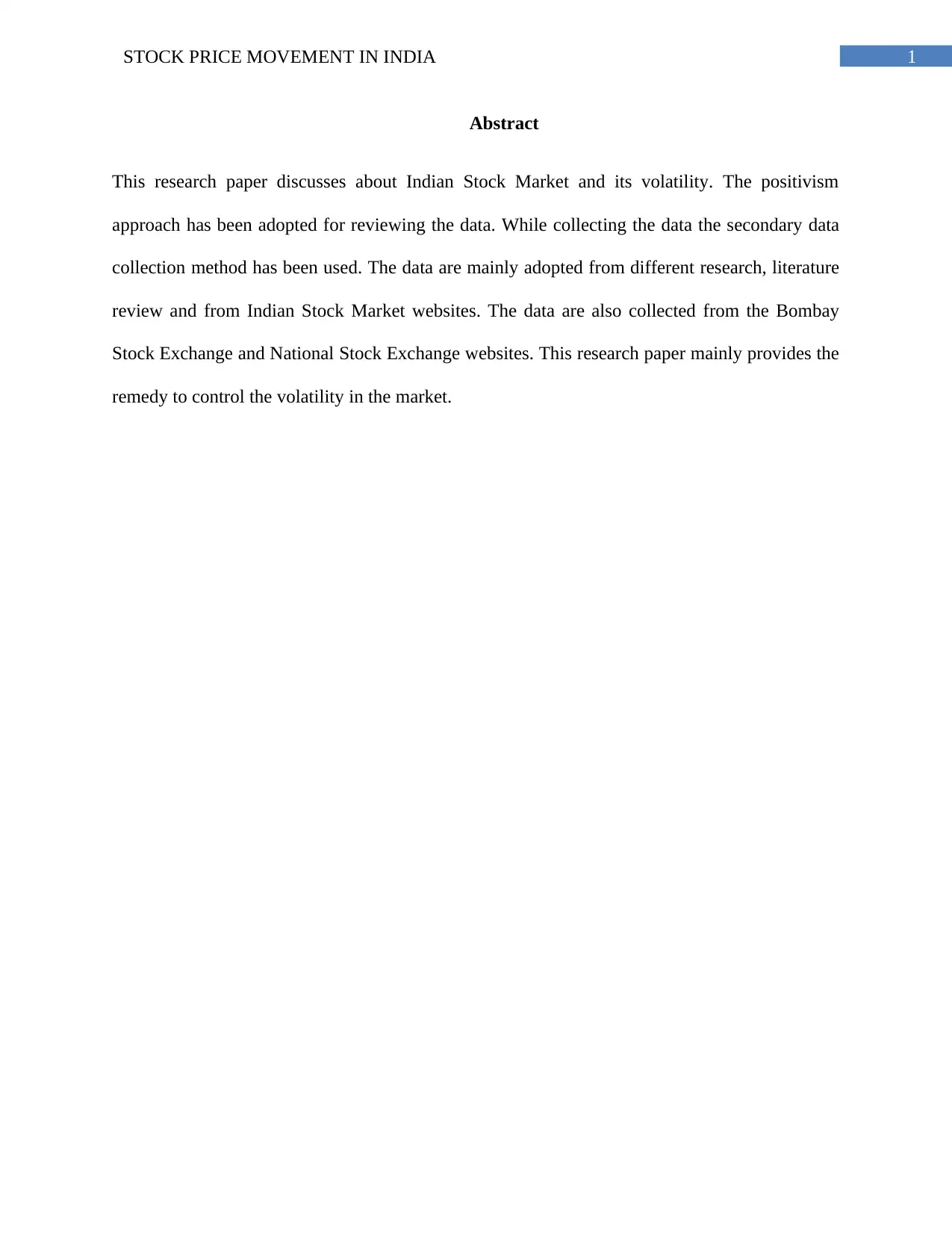
1STOCK PRICE MOVEMENT IN INDIA
Abstract
This research paper discusses about Indian Stock Market and its volatility. The positivism
approach has been adopted for reviewing the data. While collecting the data the secondary data
collection method has been used. The data are mainly adopted from different research, literature
review and from Indian Stock Market websites. The data are also collected from the Bombay
Stock Exchange and National Stock Exchange websites. This research paper mainly provides the
remedy to control the volatility in the market.
Abstract
This research paper discusses about Indian Stock Market and its volatility. The positivism
approach has been adopted for reviewing the data. While collecting the data the secondary data
collection method has been used. The data are mainly adopted from different research, literature
review and from Indian Stock Market websites. The data are also collected from the Bombay
Stock Exchange and National Stock Exchange websites. This research paper mainly provides the
remedy to control the volatility in the market.

2STOCK PRICE MOVEMENT IN INDIA
Table of Contents
INTRODUCTION...........................................................................................................................3
Introduction......................................................................................................................................3
Historical Background.....................................................................................................................4
Present Day Trading Mechanism.....................................................................................................5
Settlement and Trading Hours of Indian Stock Market...................................................................5
Market Index....................................................................................................................................6
Indian Stock Market Regulation......................................................................................................6
Investors in Indian Stock Market.....................................................................................................6
Investments in Foreign Entitles.......................................................................................................7
Reasons for Volatility......................................................................................................................7
Research Objectives.........................................................................................................................7
Research Questions..........................................................................................................................8
RESEARCH METHODOLOGY....................................................................................................9
Introduction......................................................................................................................................9
Research Philosophy........................................................................................................................9
Research Approach........................................................................................................................10
Research Strategy..........................................................................................................................10
Research Design............................................................................................................................11
Data Collection..............................................................................................................................11
Table of Contents
INTRODUCTION...........................................................................................................................3
Introduction......................................................................................................................................3
Historical Background.....................................................................................................................4
Present Day Trading Mechanism.....................................................................................................5
Settlement and Trading Hours of Indian Stock Market...................................................................5
Market Index....................................................................................................................................6
Indian Stock Market Regulation......................................................................................................6
Investors in Indian Stock Market.....................................................................................................6
Investments in Foreign Entitles.......................................................................................................7
Reasons for Volatility......................................................................................................................7
Research Objectives.........................................................................................................................7
Research Questions..........................................................................................................................8
RESEARCH METHODOLOGY....................................................................................................9
Introduction......................................................................................................................................9
Research Philosophy........................................................................................................................9
Research Approach........................................................................................................................10
Research Strategy..........................................................................................................................10
Research Design............................................................................................................................11
Data Collection..............................................................................................................................11
⊘ This is a preview!⊘
Do you want full access?
Subscribe today to unlock all pages.

Trusted by 1+ million students worldwide
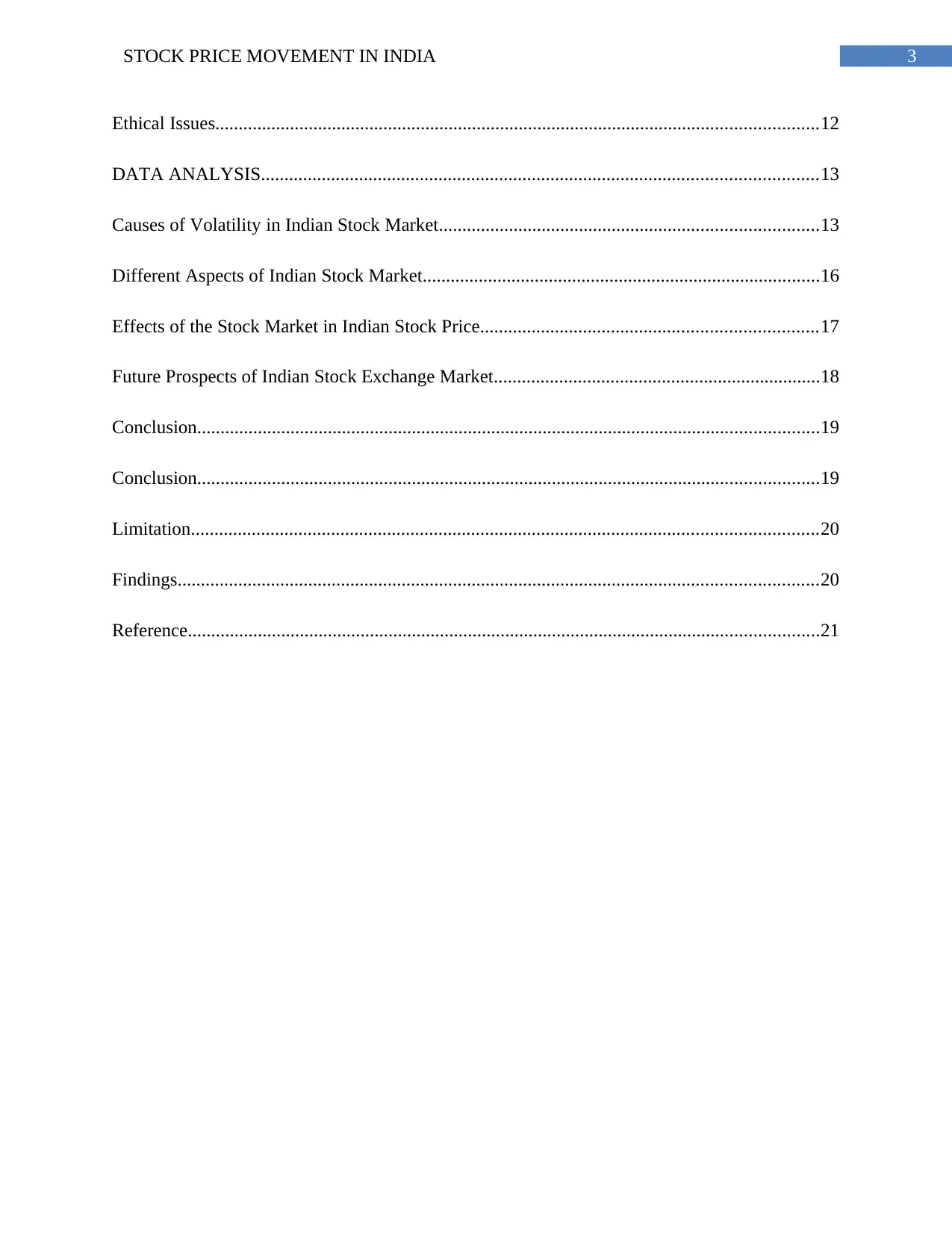
3STOCK PRICE MOVEMENT IN INDIA
Ethical Issues.................................................................................................................................12
DATA ANALYSIS.......................................................................................................................13
Causes of Volatility in Indian Stock Market.................................................................................13
Different Aspects of Indian Stock Market.....................................................................................16
Effects of the Stock Market in Indian Stock Price........................................................................17
Future Prospects of Indian Stock Exchange Market......................................................................18
Conclusion.....................................................................................................................................19
Conclusion.....................................................................................................................................19
Limitation......................................................................................................................................20
Findings.........................................................................................................................................20
Reference.......................................................................................................................................21
Ethical Issues.................................................................................................................................12
DATA ANALYSIS.......................................................................................................................13
Causes of Volatility in Indian Stock Market.................................................................................13
Different Aspects of Indian Stock Market.....................................................................................16
Effects of the Stock Market in Indian Stock Price........................................................................17
Future Prospects of Indian Stock Exchange Market......................................................................18
Conclusion.....................................................................................................................................19
Conclusion.....................................................................................................................................19
Limitation......................................................................................................................................20
Findings.........................................................................................................................................20
Reference.......................................................................................................................................21
Paraphrase This Document
Need a fresh take? Get an instant paraphrase of this document with our AI Paraphraser

4STOCK PRICE MOVEMENT IN INDIA
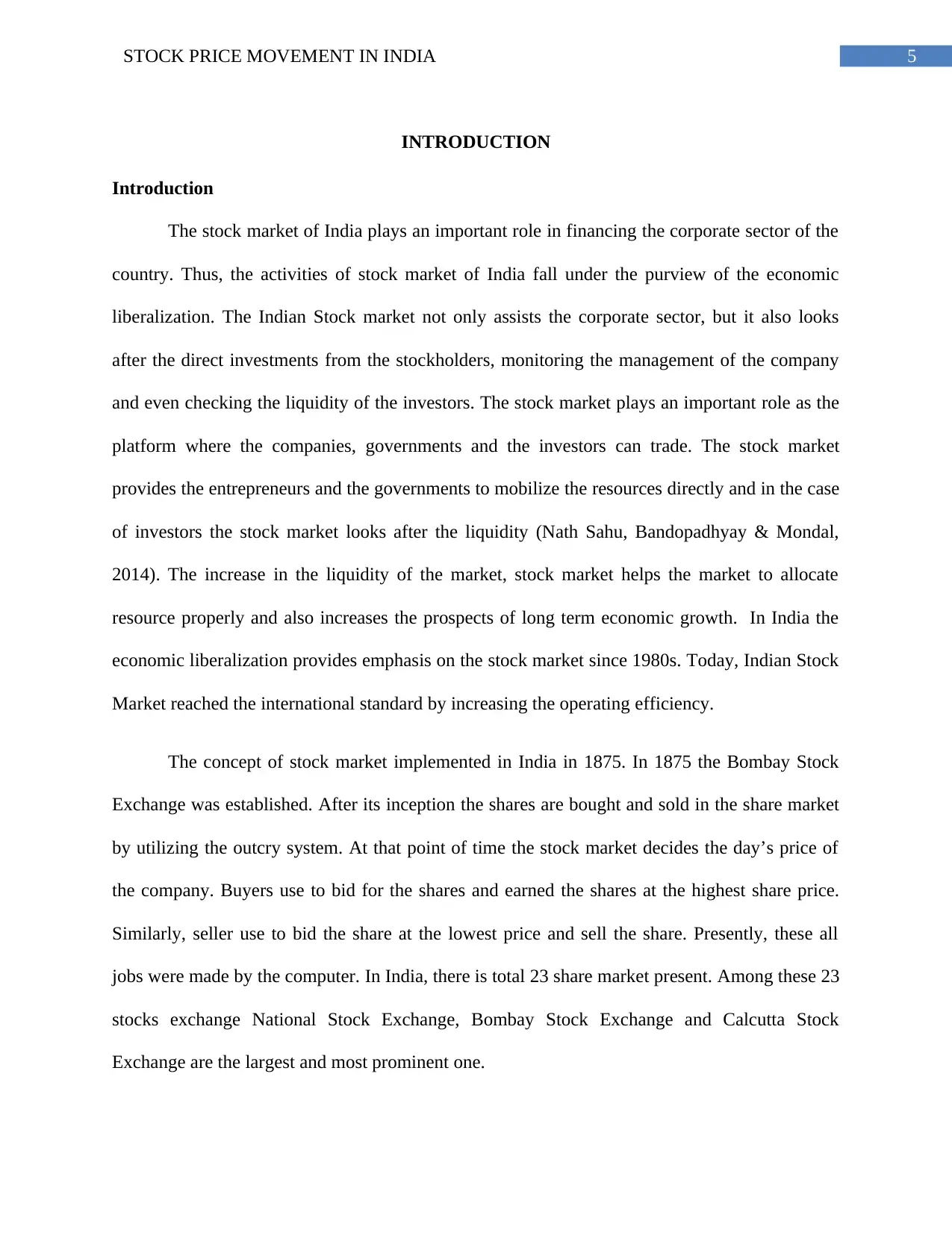
5STOCK PRICE MOVEMENT IN INDIA
INTRODUCTION
Introduction
The stock market of India plays an important role in financing the corporate sector of the
country. Thus, the activities of stock market of India fall under the purview of the economic
liberalization. The Indian Stock market not only assists the corporate sector, but it also looks
after the direct investments from the stockholders, monitoring the management of the company
and even checking the liquidity of the investors. The stock market plays an important role as the
platform where the companies, governments and the investors can trade. The stock market
provides the entrepreneurs and the governments to mobilize the resources directly and in the case
of investors the stock market looks after the liquidity (Nath Sahu, Bandopadhyay & Mondal,
2014). The increase in the liquidity of the market, stock market helps the market to allocate
resource properly and also increases the prospects of long term economic growth. In India the
economic liberalization provides emphasis on the stock market since 1980s. Today, Indian Stock
Market reached the international standard by increasing the operating efficiency.
The concept of stock market implemented in India in 1875. In 1875 the Bombay Stock
Exchange was established. After its inception the shares are bought and sold in the share market
by utilizing the outcry system. At that point of time the stock market decides the day’s price of
the company. Buyers use to bid for the shares and earned the shares at the highest share price.
Similarly, seller use to bid the share at the lowest price and sell the share. Presently, these all
jobs were made by the computer. In India, there is total 23 share market present. Among these 23
stocks exchange National Stock Exchange, Bombay Stock Exchange and Calcutta Stock
Exchange are the largest and most prominent one.
INTRODUCTION
Introduction
The stock market of India plays an important role in financing the corporate sector of the
country. Thus, the activities of stock market of India fall under the purview of the economic
liberalization. The Indian Stock market not only assists the corporate sector, but it also looks
after the direct investments from the stockholders, monitoring the management of the company
and even checking the liquidity of the investors. The stock market plays an important role as the
platform where the companies, governments and the investors can trade. The stock market
provides the entrepreneurs and the governments to mobilize the resources directly and in the case
of investors the stock market looks after the liquidity (Nath Sahu, Bandopadhyay & Mondal,
2014). The increase in the liquidity of the market, stock market helps the market to allocate
resource properly and also increases the prospects of long term economic growth. In India the
economic liberalization provides emphasis on the stock market since 1980s. Today, Indian Stock
Market reached the international standard by increasing the operating efficiency.
The concept of stock market implemented in India in 1875. In 1875 the Bombay Stock
Exchange was established. After its inception the shares are bought and sold in the share market
by utilizing the outcry system. At that point of time the stock market decides the day’s price of
the company. Buyers use to bid for the shares and earned the shares at the highest share price.
Similarly, seller use to bid the share at the lowest price and sell the share. Presently, these all
jobs were made by the computer. In India, there is total 23 share market present. Among these 23
stocks exchange National Stock Exchange, Bombay Stock Exchange and Calcutta Stock
Exchange are the largest and most prominent one.
⊘ This is a preview!⊘
Do you want full access?
Subscribe today to unlock all pages.

Trusted by 1+ million students worldwide
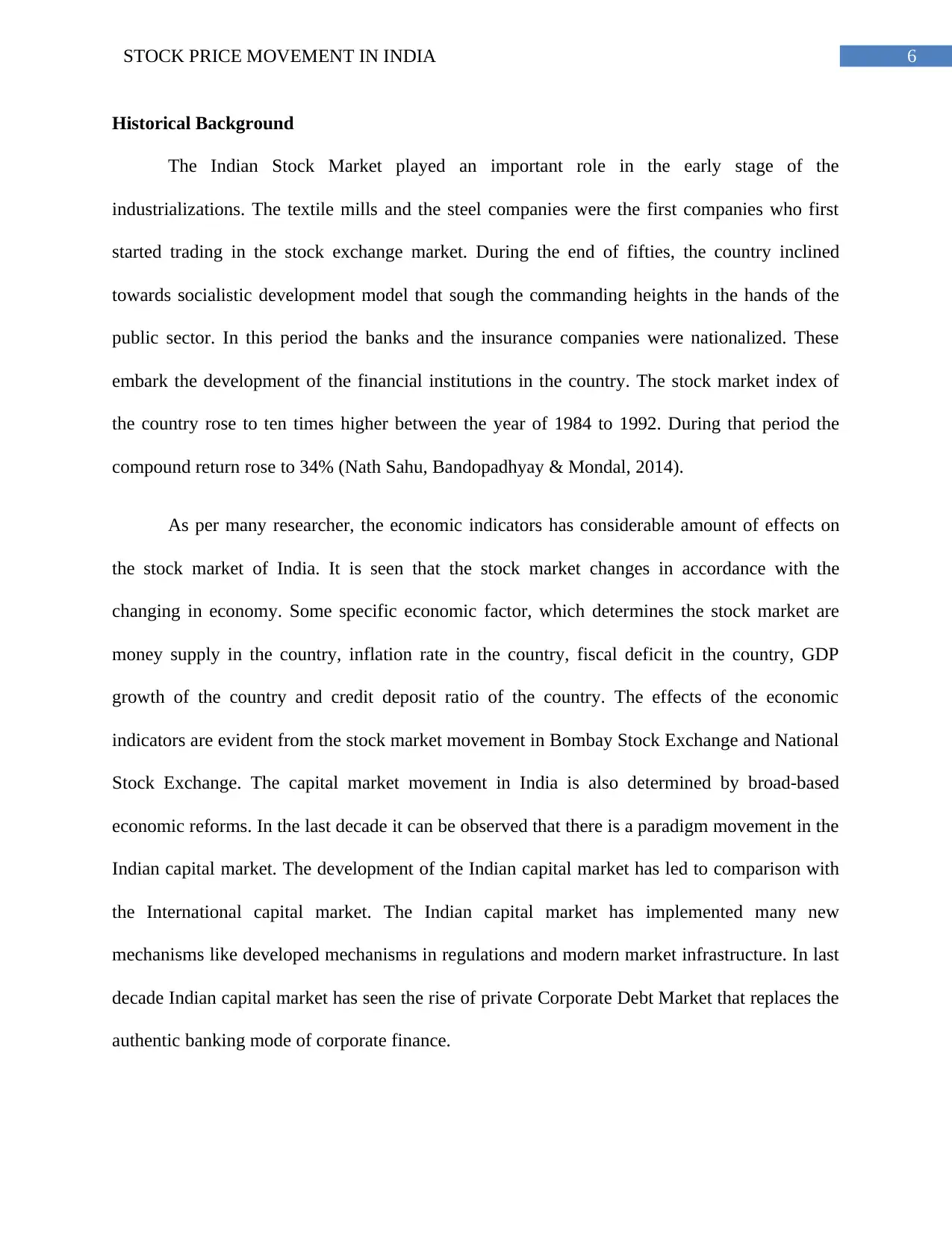
6STOCK PRICE MOVEMENT IN INDIA
Historical Background
The Indian Stock Market played an important role in the early stage of the
industrializations. The textile mills and the steel companies were the first companies who first
started trading in the stock exchange market. During the end of fifties, the country inclined
towards socialistic development model that sough the commanding heights in the hands of the
public sector. In this period the banks and the insurance companies were nationalized. These
embark the development of the financial institutions in the country. The stock market index of
the country rose to ten times higher between the year of 1984 to 1992. During that period the
compound return rose to 34% (Nath Sahu, Bandopadhyay & Mondal, 2014).
As per many researcher, the economic indicators has considerable amount of effects on
the stock market of India. It is seen that the stock market changes in accordance with the
changing in economy. Some specific economic factor, which determines the stock market are
money supply in the country, inflation rate in the country, fiscal deficit in the country, GDP
growth of the country and credit deposit ratio of the country. The effects of the economic
indicators are evident from the stock market movement in Bombay Stock Exchange and National
Stock Exchange. The capital market movement in India is also determined by broad-based
economic reforms. In the last decade it can be observed that there is a paradigm movement in the
Indian capital market. The development of the Indian capital market has led to comparison with
the International capital market. The Indian capital market has implemented many new
mechanisms like developed mechanisms in regulations and modern market infrastructure. In last
decade Indian capital market has seen the rise of private Corporate Debt Market that replaces the
authentic banking mode of corporate finance.
Historical Background
The Indian Stock Market played an important role in the early stage of the
industrializations. The textile mills and the steel companies were the first companies who first
started trading in the stock exchange market. During the end of fifties, the country inclined
towards socialistic development model that sough the commanding heights in the hands of the
public sector. In this period the banks and the insurance companies were nationalized. These
embark the development of the financial institutions in the country. The stock market index of
the country rose to ten times higher between the year of 1984 to 1992. During that period the
compound return rose to 34% (Nath Sahu, Bandopadhyay & Mondal, 2014).
As per many researcher, the economic indicators has considerable amount of effects on
the stock market of India. It is seen that the stock market changes in accordance with the
changing in economy. Some specific economic factor, which determines the stock market are
money supply in the country, inflation rate in the country, fiscal deficit in the country, GDP
growth of the country and credit deposit ratio of the country. The effects of the economic
indicators are evident from the stock market movement in Bombay Stock Exchange and National
Stock Exchange. The capital market movement in India is also determined by broad-based
economic reforms. In the last decade it can be observed that there is a paradigm movement in the
Indian capital market. The development of the Indian capital market has led to comparison with
the International capital market. The Indian capital market has implemented many new
mechanisms like developed mechanisms in regulations and modern market infrastructure. In last
decade Indian capital market has seen the rise of private Corporate Debt Market that replaces the
authentic banking mode of corporate finance.
Paraphrase This Document
Need a fresh take? Get an instant paraphrase of this document with our AI Paraphraser
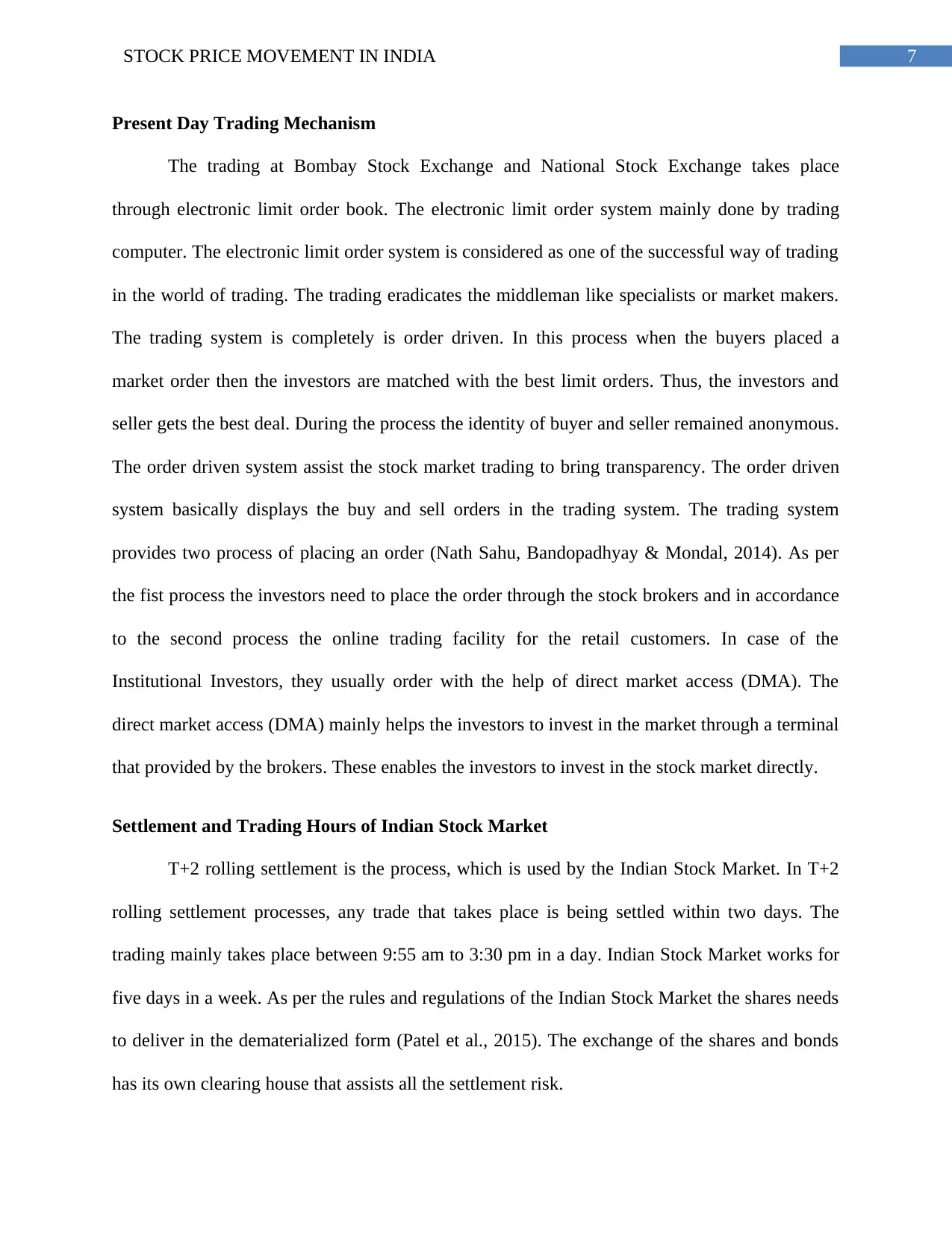
7STOCK PRICE MOVEMENT IN INDIA
Present Day Trading Mechanism
The trading at Bombay Stock Exchange and National Stock Exchange takes place
through electronic limit order book. The electronic limit order system mainly done by trading
computer. The electronic limit order system is considered as one of the successful way of trading
in the world of trading. The trading eradicates the middleman like specialists or market makers.
The trading system is completely is order driven. In this process when the buyers placed a
market order then the investors are matched with the best limit orders. Thus, the investors and
seller gets the best deal. During the process the identity of buyer and seller remained anonymous.
The order driven system assist the stock market trading to bring transparency. The order driven
system basically displays the buy and sell orders in the trading system. The trading system
provides two process of placing an order (Nath Sahu, Bandopadhyay & Mondal, 2014). As per
the fist process the investors need to place the order through the stock brokers and in accordance
to the second process the online trading facility for the retail customers. In case of the
Institutional Investors, they usually order with the help of direct market access (DMA). The
direct market access (DMA) mainly helps the investors to invest in the market through a terminal
that provided by the brokers. These enables the investors to invest in the stock market directly.
Settlement and Trading Hours of Indian Stock Market
T+2 rolling settlement is the process, which is used by the Indian Stock Market. In T+2
rolling settlement processes, any trade that takes place is being settled within two days. The
trading mainly takes place between 9:55 am to 3:30 pm in a day. Indian Stock Market works for
five days in a week. As per the rules and regulations of the Indian Stock Market the shares needs
to deliver in the dematerialized form (Patel et al., 2015). The exchange of the shares and bonds
has its own clearing house that assists all the settlement risk.
Present Day Trading Mechanism
The trading at Bombay Stock Exchange and National Stock Exchange takes place
through electronic limit order book. The electronic limit order system mainly done by trading
computer. The electronic limit order system is considered as one of the successful way of trading
in the world of trading. The trading eradicates the middleman like specialists or market makers.
The trading system is completely is order driven. In this process when the buyers placed a
market order then the investors are matched with the best limit orders. Thus, the investors and
seller gets the best deal. During the process the identity of buyer and seller remained anonymous.
The order driven system assist the stock market trading to bring transparency. The order driven
system basically displays the buy and sell orders in the trading system. The trading system
provides two process of placing an order (Nath Sahu, Bandopadhyay & Mondal, 2014). As per
the fist process the investors need to place the order through the stock brokers and in accordance
to the second process the online trading facility for the retail customers. In case of the
Institutional Investors, they usually order with the help of direct market access (DMA). The
direct market access (DMA) mainly helps the investors to invest in the market through a terminal
that provided by the brokers. These enables the investors to invest in the stock market directly.
Settlement and Trading Hours of Indian Stock Market
T+2 rolling settlement is the process, which is used by the Indian Stock Market. In T+2
rolling settlement processes, any trade that takes place is being settled within two days. The
trading mainly takes place between 9:55 am to 3:30 pm in a day. Indian Stock Market works for
five days in a week. As per the rules and regulations of the Indian Stock Market the shares needs
to deliver in the dematerialized form (Patel et al., 2015). The exchange of the shares and bonds
has its own clearing house that assists all the settlement risk.
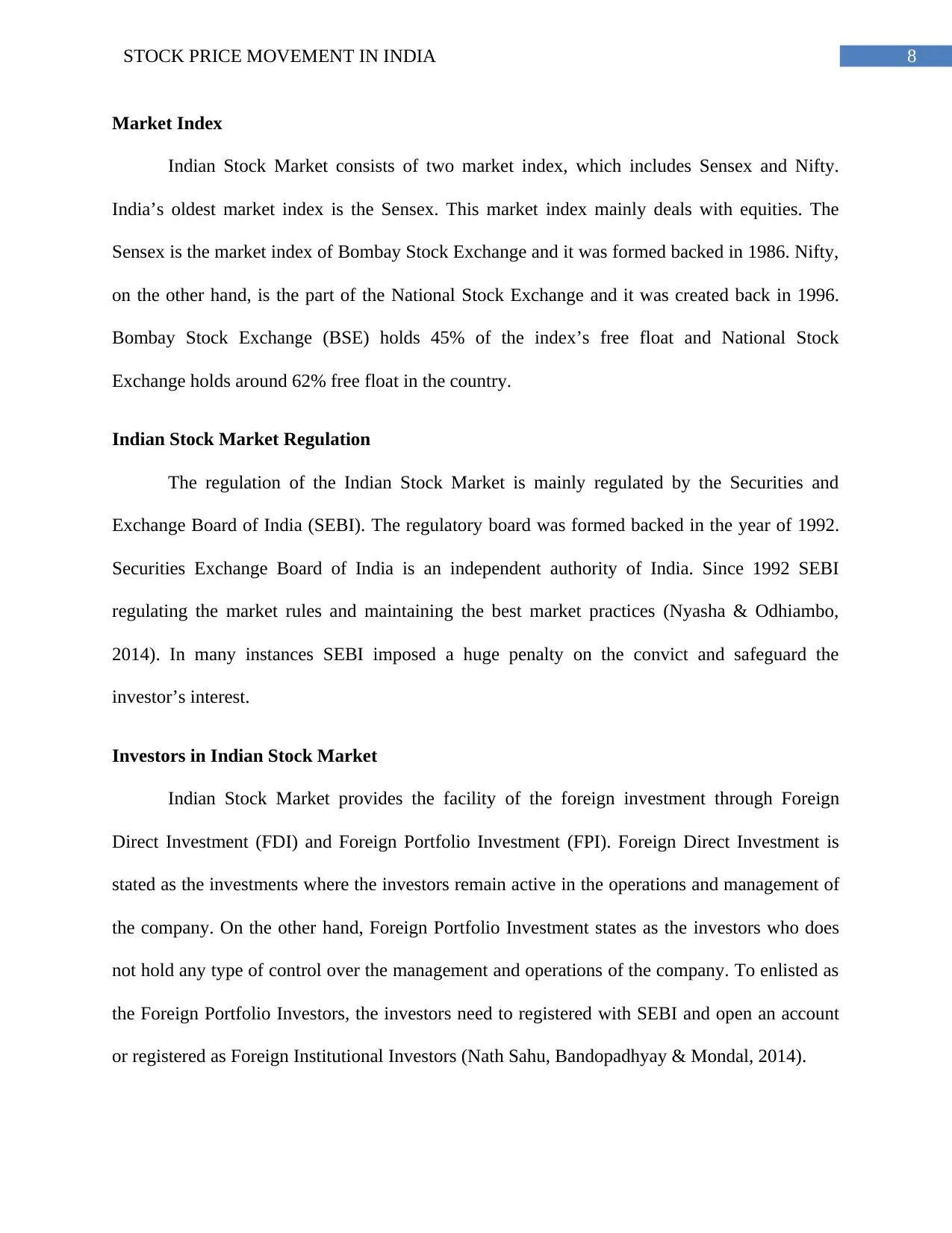
8STOCK PRICE MOVEMENT IN INDIA
Market Index
Indian Stock Market consists of two market index, which includes Sensex and Nifty.
India’s oldest market index is the Sensex. This market index mainly deals with equities. The
Sensex is the market index of Bombay Stock Exchange and it was formed backed in 1986. Nifty,
on the other hand, is the part of the National Stock Exchange and it was created back in 1996.
Bombay Stock Exchange (BSE) holds 45% of the index’s free float and National Stock
Exchange holds around 62% free float in the country.
Indian Stock Market Regulation
The regulation of the Indian Stock Market is mainly regulated by the Securities and
Exchange Board of India (SEBI). The regulatory board was formed backed in the year of 1992.
Securities Exchange Board of India is an independent authority of India. Since 1992 SEBI
regulating the market rules and maintaining the best market practices (Nyasha & Odhiambo,
2014). In many instances SEBI imposed a huge penalty on the convict and safeguard the
investor’s interest.
Investors in Indian Stock Market
Indian Stock Market provides the facility of the foreign investment through Foreign
Direct Investment (FDI) and Foreign Portfolio Investment (FPI). Foreign Direct Investment is
stated as the investments where the investors remain active in the operations and management of
the company. On the other hand, Foreign Portfolio Investment states as the investors who does
not hold any type of control over the management and operations of the company. To enlisted as
the Foreign Portfolio Investors, the investors need to registered with SEBI and open an account
or registered as Foreign Institutional Investors (Nath Sahu, Bandopadhyay & Mondal, 2014).
Market Index
Indian Stock Market consists of two market index, which includes Sensex and Nifty.
India’s oldest market index is the Sensex. This market index mainly deals with equities. The
Sensex is the market index of Bombay Stock Exchange and it was formed backed in 1986. Nifty,
on the other hand, is the part of the National Stock Exchange and it was created back in 1996.
Bombay Stock Exchange (BSE) holds 45% of the index’s free float and National Stock
Exchange holds around 62% free float in the country.
Indian Stock Market Regulation
The regulation of the Indian Stock Market is mainly regulated by the Securities and
Exchange Board of India (SEBI). The regulatory board was formed backed in the year of 1992.
Securities Exchange Board of India is an independent authority of India. Since 1992 SEBI
regulating the market rules and maintaining the best market practices (Nyasha & Odhiambo,
2014). In many instances SEBI imposed a huge penalty on the convict and safeguard the
investor’s interest.
Investors in Indian Stock Market
Indian Stock Market provides the facility of the foreign investment through Foreign
Direct Investment (FDI) and Foreign Portfolio Investment (FPI). Foreign Direct Investment is
stated as the investments where the investors remain active in the operations and management of
the company. On the other hand, Foreign Portfolio Investment states as the investors who does
not hold any type of control over the management and operations of the company. To enlisted as
the Foreign Portfolio Investors, the investors need to registered with SEBI and open an account
or registered as Foreign Institutional Investors (Nath Sahu, Bandopadhyay & Mondal, 2014).
⊘ This is a preview!⊘
Do you want full access?
Subscribe today to unlock all pages.

Trusted by 1+ million students worldwide
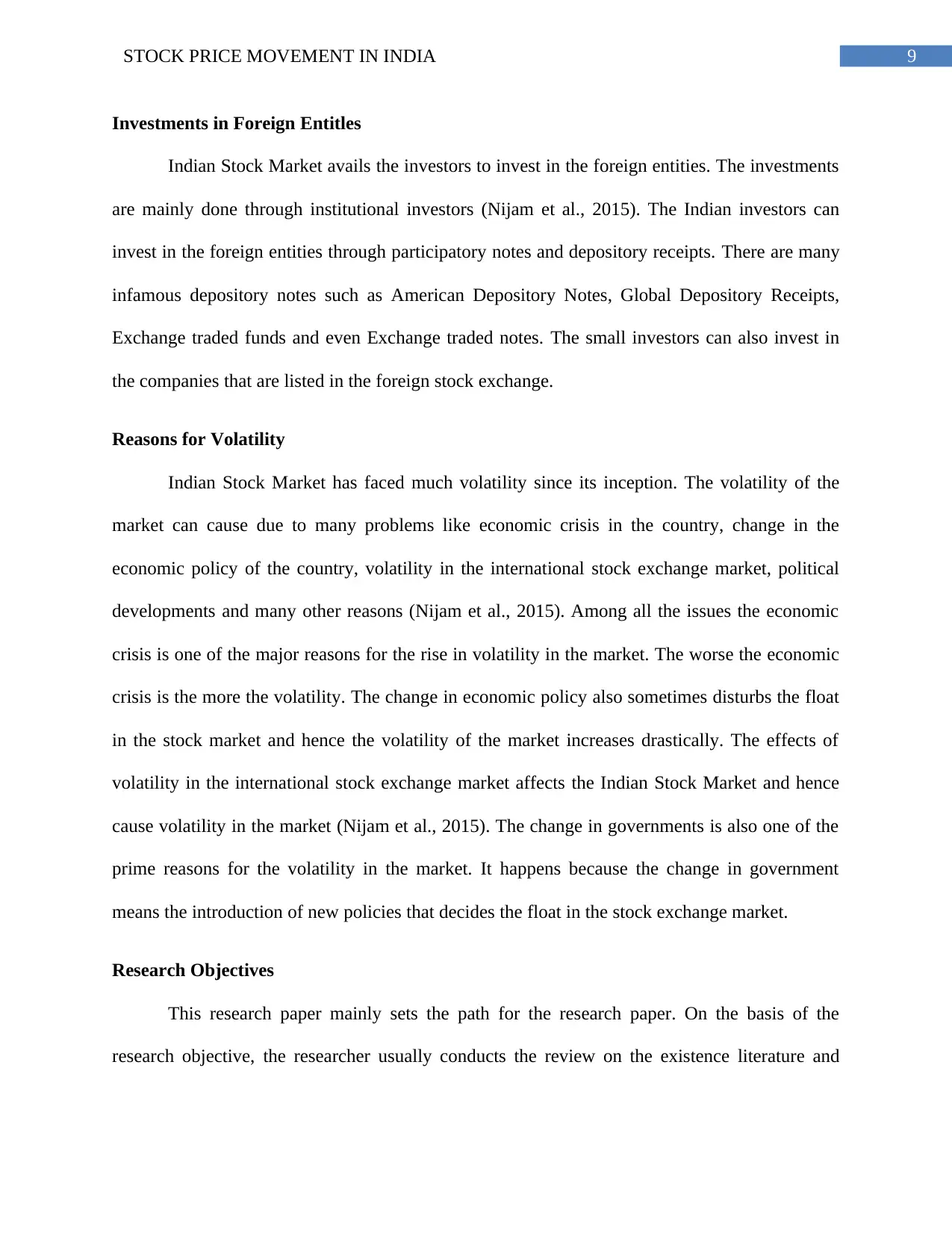
9STOCK PRICE MOVEMENT IN INDIA
Investments in Foreign Entitles
Indian Stock Market avails the investors to invest in the foreign entities. The investments
are mainly done through institutional investors (Nijam et al., 2015). The Indian investors can
invest in the foreign entities through participatory notes and depository receipts. There are many
infamous depository notes such as American Depository Notes, Global Depository Receipts,
Exchange traded funds and even Exchange traded notes. The small investors can also invest in
the companies that are listed in the foreign stock exchange.
Reasons for Volatility
Indian Stock Market has faced much volatility since its inception. The volatility of the
market can cause due to many problems like economic crisis in the country, change in the
economic policy of the country, volatility in the international stock exchange market, political
developments and many other reasons (Nijam et al., 2015). Among all the issues the economic
crisis is one of the major reasons for the rise in volatility in the market. The worse the economic
crisis is the more the volatility. The change in economic policy also sometimes disturbs the float
in the stock market and hence the volatility of the market increases drastically. The effects of
volatility in the international stock exchange market affects the Indian Stock Market and hence
cause volatility in the market (Nijam et al., 2015). The change in governments is also one of the
prime reasons for the volatility in the market. It happens because the change in government
means the introduction of new policies that decides the float in the stock exchange market.
Research Objectives
This research paper mainly sets the path for the research paper. On the basis of the
research objective, the researcher usually conducts the review on the existence literature and
Investments in Foreign Entitles
Indian Stock Market avails the investors to invest in the foreign entities. The investments
are mainly done through institutional investors (Nijam et al., 2015). The Indian investors can
invest in the foreign entities through participatory notes and depository receipts. There are many
infamous depository notes such as American Depository Notes, Global Depository Receipts,
Exchange traded funds and even Exchange traded notes. The small investors can also invest in
the companies that are listed in the foreign stock exchange.
Reasons for Volatility
Indian Stock Market has faced much volatility since its inception. The volatility of the
market can cause due to many problems like economic crisis in the country, change in the
economic policy of the country, volatility in the international stock exchange market, political
developments and many other reasons (Nijam et al., 2015). Among all the issues the economic
crisis is one of the major reasons for the rise in volatility in the market. The worse the economic
crisis is the more the volatility. The change in economic policy also sometimes disturbs the float
in the stock market and hence the volatility of the market increases drastically. The effects of
volatility in the international stock exchange market affects the Indian Stock Market and hence
cause volatility in the market (Nijam et al., 2015). The change in governments is also one of the
prime reasons for the volatility in the market. It happens because the change in government
means the introduction of new policies that decides the float in the stock exchange market.
Research Objectives
This research paper mainly sets the path for the research paper. On the basis of the
research objective, the researcher usually conducts the review on the existence literature and
Paraphrase This Document
Need a fresh take? Get an instant paraphrase of this document with our AI Paraphraser

10STOCK PRICE MOVEMENT IN INDIA
analysis of the data that are usually collected for the paper. This research paper depends on the
two research objectives. They are as follows:
To identify the different aspects of Indian Stock Market
To identify the importance of economic growth of Indian Stock Market
To identify the movements of the Indian Stock Market
To identify the future prospects of Indian Stock Market
To identify the key areas that affects the Indian Stock Market
To identify the ways for controlling the volatility of the market
Research Questions
This research paper is based on answering the specific concern or the issues. This is the
foremost step after the idea of study is generated. It helps in providing the enough specifics,
which helps in understanding the purposes without having the need for additional explanation.
This research paper is based on answering the following questions of stock market:
What are the different aspects of the Indian Stock Market?
How economy growth has resulted into movements of Indian stock prices?
What are the past as well as current movements in the Indian Stock Market?
What are the future prospects of the Indian Stock Market?
How to help the current as well as potential investors for understanding the impact of
the key happenings on the stock exchanges of India?
What are the measures that have been adopted for controlling the volatility?
analysis of the data that are usually collected for the paper. This research paper depends on the
two research objectives. They are as follows:
To identify the different aspects of Indian Stock Market
To identify the importance of economic growth of Indian Stock Market
To identify the movements of the Indian Stock Market
To identify the future prospects of Indian Stock Market
To identify the key areas that affects the Indian Stock Market
To identify the ways for controlling the volatility of the market
Research Questions
This research paper is based on answering the specific concern or the issues. This is the
foremost step after the idea of study is generated. It helps in providing the enough specifics,
which helps in understanding the purposes without having the need for additional explanation.
This research paper is based on answering the following questions of stock market:
What are the different aspects of the Indian Stock Market?
How economy growth has resulted into movements of Indian stock prices?
What are the past as well as current movements in the Indian Stock Market?
What are the future prospects of the Indian Stock Market?
How to help the current as well as potential investors for understanding the impact of
the key happenings on the stock exchanges of India?
What are the measures that have been adopted for controlling the volatility?
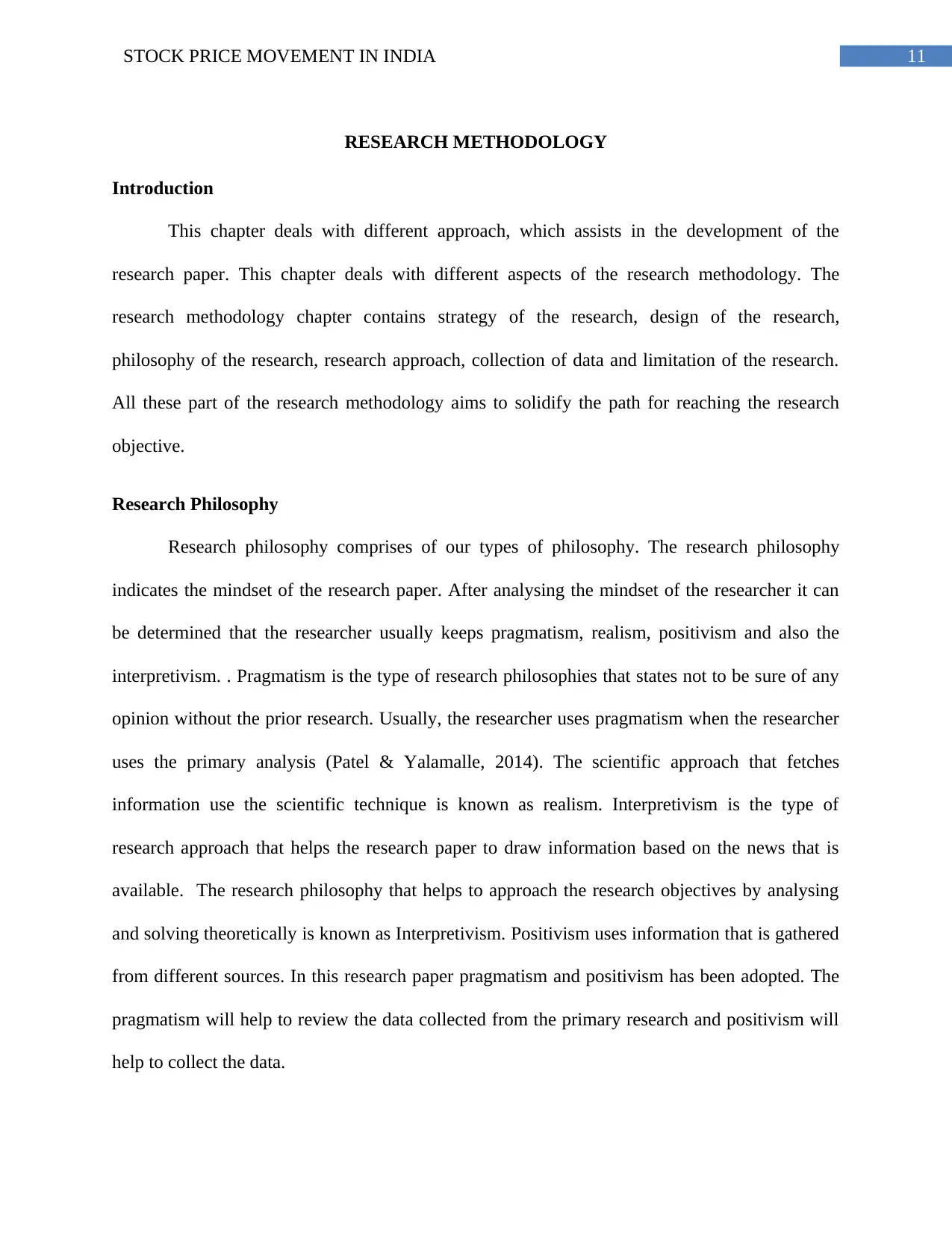
11STOCK PRICE MOVEMENT IN INDIA
RESEARCH METHODOLOGY
Introduction
This chapter deals with different approach, which assists in the development of the
research paper. This chapter deals with different aspects of the research methodology. The
research methodology chapter contains strategy of the research, design of the research,
philosophy of the research, research approach, collection of data and limitation of the research.
All these part of the research methodology aims to solidify the path for reaching the research
objective.
Research Philosophy
Research philosophy comprises of our types of philosophy. The research philosophy
indicates the mindset of the research paper. After analysing the mindset of the researcher it can
be determined that the researcher usually keeps pragmatism, realism, positivism and also the
interpretivism. . Pragmatism is the type of research philosophies that states not to be sure of any
opinion without the prior research. Usually, the researcher uses pragmatism when the researcher
uses the primary analysis (Patel & Yalamalle, 2014). The scientific approach that fetches
information use the scientific technique is known as realism. Interpretivism is the type of
research approach that helps the research paper to draw information based on the news that is
available. The research philosophy that helps to approach the research objectives by analysing
and solving theoretically is known as Interpretivism. Positivism uses information that is gathered
from different sources. In this research paper pragmatism and positivism has been adopted. The
pragmatism will help to review the data collected from the primary research and positivism will
help to collect the data.
RESEARCH METHODOLOGY
Introduction
This chapter deals with different approach, which assists in the development of the
research paper. This chapter deals with different aspects of the research methodology. The
research methodology chapter contains strategy of the research, design of the research,
philosophy of the research, research approach, collection of data and limitation of the research.
All these part of the research methodology aims to solidify the path for reaching the research
objective.
Research Philosophy
Research philosophy comprises of our types of philosophy. The research philosophy
indicates the mindset of the research paper. After analysing the mindset of the researcher it can
be determined that the researcher usually keeps pragmatism, realism, positivism and also the
interpretivism. . Pragmatism is the type of research philosophies that states not to be sure of any
opinion without the prior research. Usually, the researcher uses pragmatism when the researcher
uses the primary analysis (Patel & Yalamalle, 2014). The scientific approach that fetches
information use the scientific technique is known as realism. Interpretivism is the type of
research approach that helps the research paper to draw information based on the news that is
available. The research philosophy that helps to approach the research objectives by analysing
and solving theoretically is known as Interpretivism. Positivism uses information that is gathered
from different sources. In this research paper pragmatism and positivism has been adopted. The
pragmatism will help to review the data collected from the primary research and positivism will
help to collect the data.
⊘ This is a preview!⊘
Do you want full access?
Subscribe today to unlock all pages.

Trusted by 1+ million students worldwide
1 out of 30
Related Documents
Your All-in-One AI-Powered Toolkit for Academic Success.
+13062052269
info@desklib.com
Available 24*7 on WhatsApp / Email
![[object Object]](/_next/static/media/star-bottom.7253800d.svg)
Unlock your academic potential
Copyright © 2020–2025 A2Z Services. All Rights Reserved. Developed and managed by ZUCOL.





